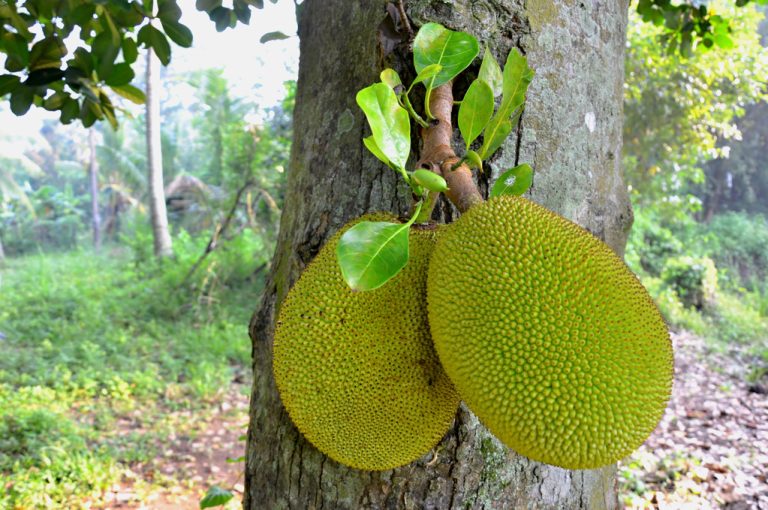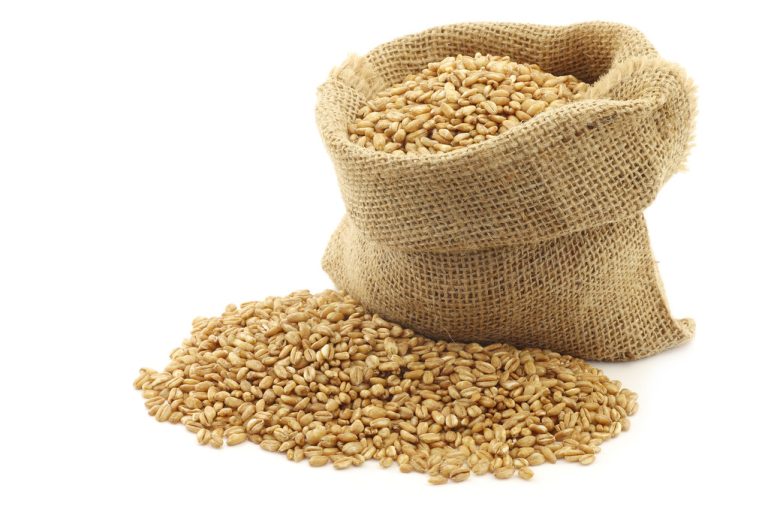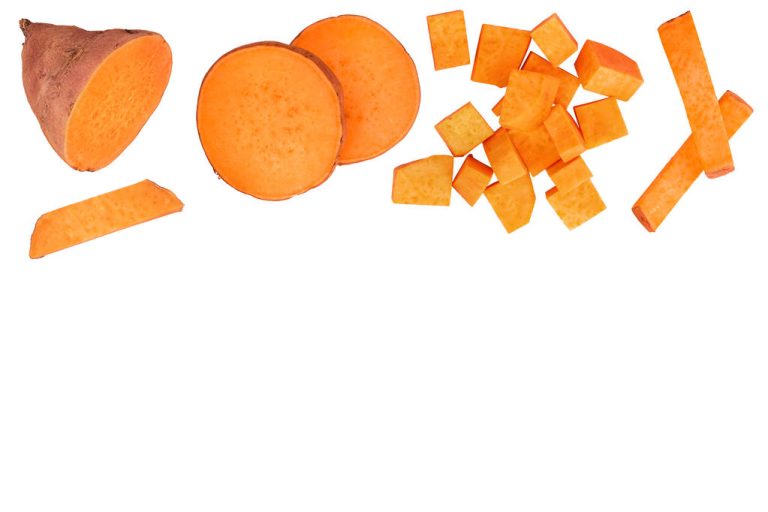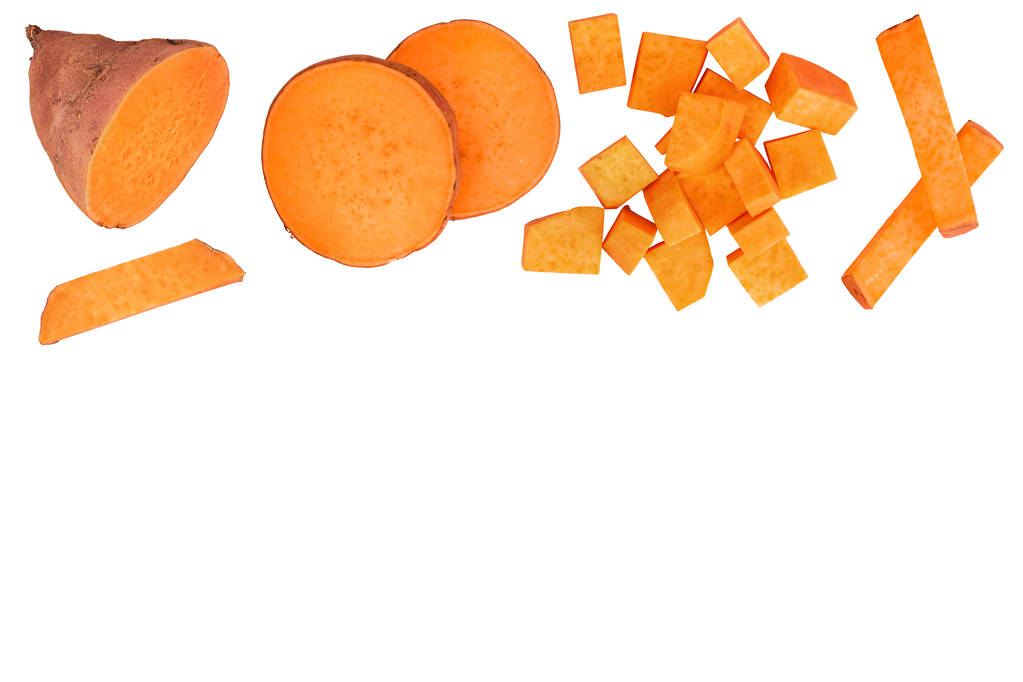A new hype for vegetarians and vegans comes from the tropics: jackfruit conquers the palate as a meat substitute. We show how useful the fruit is as an alternative to meat and where you can already buy jackfruit.
Jackfruit grows in the tropics around the world and is usually eaten ripe and sweet in its countries of origin. Depending on the variety, a single fruit can weigh up to 35 kilos. The jackfruit tree can grow up to 20 meters tall, but bears its fruit on the trunk, making it easier to harvest. If you cut open the ripe fruit, a milky juice comes out that is reminiscent of glue. No wonder, because it belongs to the mulberry family – like the rubber tree (Ficus), which has the same sticky property.
In its countries of origin, the ripe jackfruit is served as a sweet dessert or eaten as a snack; similar to bananas, it is often dried into crispy chips. The kernels are also used: either dried and ground into flour or roasted as an addition to savory dishes.
Jackfruit has recently been rediscovered as a meat substitute. However, this is less so in their countries of origin than on the plates of vegetarians and vegans in western countries.
Jackfruit as a meat substitute
In order to use the tropical fruit as a substitute for meat in hearty vegetarian or vegan dishes, it must be harvested unripe. When ripe, their taste is reminiscent of fruit gum and would be out of place in goulash. Raw, however, the unripe fruits are inedible and hard, only their further processing makes them the fine-grained substitute for beef, pork or chicken.
In order to give the jackfruit tree enough strength to let a few jackfruit grow big, sweet and juicy, some smaller fruits are knocked off the tree unripe in the course of fruit growth. Every hobby gardener knows the method of “cutting out” the native tomato plants, every winegrower does the same thing in his vineyard on the vine.
Instead of disposing of these sorted unripe fruits, they are placed in brine for the local market or, more recently, processed into meat substitutes for export to western industrialized countries. The unripe, fibrous flesh is almost tasteless and can therefore be marinated to taste.
If the fruit pieces are cooked in a marinade and then seared, they are very reminiscent of meat. The crust also creates an almost perfect optical illusion. After all, it is the spices that determine the taste of meat.
Where can you buy jackfruit?
If you want to get started right away to conjure up a vegetarian goulash, a tender vegan “pulled pork” or a juicy burger, you won’t find what you’re looking for in every supermarket right away. Most of the canned or frozen pulp sold in Asian stores was harvested ripe. It tastes delicious, but it is only good as a fruity dessert, not as a hearty ingredient in meatless dishes.
If you are lucky enough to have the list of ingredients translated by the sales staff or do some research, you can also find unripe jackfruit pickled in brine in Asian, mostly Indian grocery stores. You can also find canned unripe jackfruit online. But before they can be used as an alternative to meat, they have to be cooked until soft by heating.
Jackfruit as a meat substitute: nutritional values similar to potatoes
Jackfruit actually mimics the fibers of meat in texture, and with spices it’s possible to create not only a similar mouthfeel, but an almost identical taste. However, the jackfruit has less to do with the nutritional values of meat. No wonder, given its high carbohydrate content, it is often served straight from the home garden as a substitute for rice in its countries of origin.
Nevertheless, jackfruit suppliers like to advertise their natural product with claims such as “nutrient-rich”, “rich in minerals”, “high in fiber”, “high in potassium”, “high in calcium and magnesium” and other advantages.
Basically, these statements are not made out of thin air, but a comparison with local food is worthwhile to decide for yourself whether it is really worth importing a jackfruit over thousands of kilometers (each per 100g):
Potassium: jackfruit 407mg; Potatoes 384mg, pumpernickel 192mg
Magnesium: Jackfruit 37mg; potatoes 22mg; Pumpernickel 54mg
Calcium: Jackfruit 27mg; potatoes 7mg; Pumpernickel 24mg
Protein: jackfruit 1.1g; potatoes 2g; Pumpernickel 4.84g
Fiber: jackfruit 4.15g; potatoes 1.56g; Pumpernickel 8.83g
While jackfruit’s reputation as a super-healthy meat substitute isn’t false, it’s also a bit blatant. As with avocados, the following therefore applies: only those who really use it to replace meat are actually better off ecologically. If you only put it on your plate for trend reasons or for alleged superfood nutritional values, you will find more ecological alternatives. (With this and other nutritional information, it should be remembered that the degree of ripeness, preparation methods, etc. also have an influence on the nutrients contained.)
Jackfruit instead of soy?
So far, the most popular meat substitute products have been protein-rich specialties made from tofu or seitan. The consistency of seitan is also somewhat similar to that of meat, but it is not suitable for people who suffer from gluten intolerance (celiac disease) or who want to avoid gluten.
Soy itself is a higher quality source of protein than meat, but not everyone likes it, has a different texture than meat and, depending on its origin, has been criticized for contributing to the deforestation of tropical forests or for being made from genetically modified soybeans.
The jackfruit’s path to success seems almost pre-programmed: it is gluten-free, has nothing to do with genetic engineering, offers an extremely meat-like mouthfeel and contains little fat. Green light for the jackfruit BBQ? Unfortunately, it’s not that simple…
Allergy to jackfruit
It’s not well-documented yet, but there is a risk of immediate allergic reactions with jackfruit. So if you are allergic anyway, you should definitely start small. Cross allergies are possible, for example, in allergies to nuts and birch pollen.
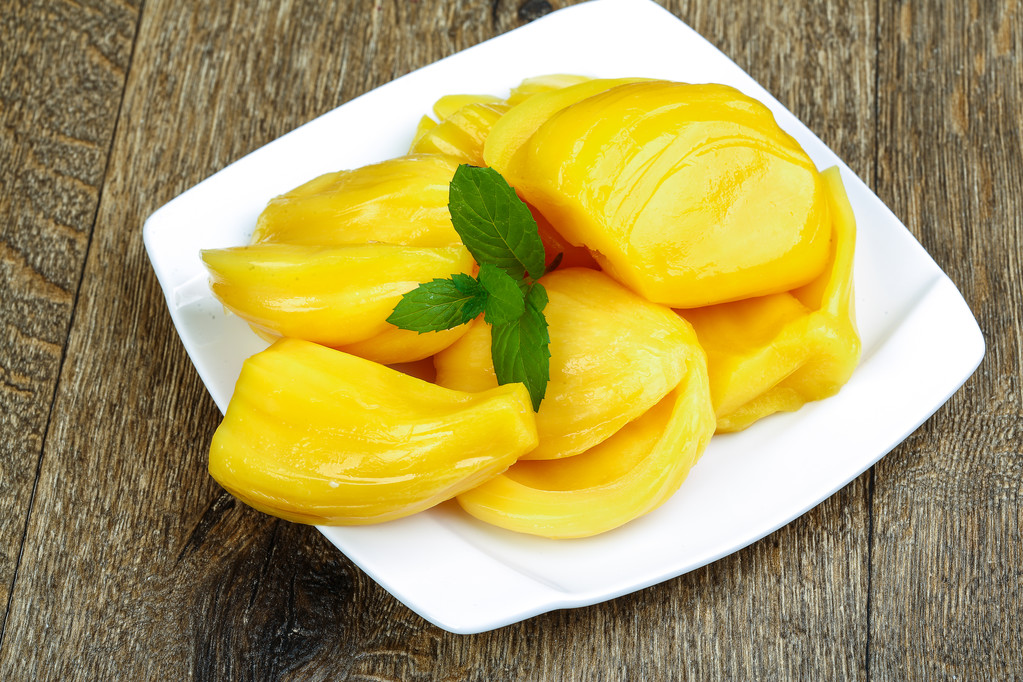
Transport routes worsen the ecological balance of the jackfruit
Those who do without meat or animal products often do so for ecological reasons. Not only the love of animals is decisive, but also the knowledge of the catastrophic ecological balance of animal-based foods is leading more and more consumers to eat vegetarian or vegan.
And that’s exactly the catch with the new meat substitute: Because the jackfruit only thrives in the tropics (especially India and Bangladesh), it already has a significant carbon footprint when it comes to our stores. Irrespective of whether it is shrink-wrapped, preserved in cans or transported and sold deep-frozen: the fruity meat alternative has already used up a lot of fossil fuels before it is eaten.
We do not yet have any publicly available data on the precise CO2 emissions from jackfruit. Nevertheless, one should at least question the jackfruit from an ecological point of view. The life cycle assessment of regional, seasonal vegetables is probably better when consumed daily.
Because jackfruit is just about to become the new star among vegans and vegetarians, there are only a few farms that cultivate the fruit according to the guidelines of organic cultivation (see above: Buy jackfruit: preferably organic). On the positive side, jackfruit is typically grown in mixed cultures.




